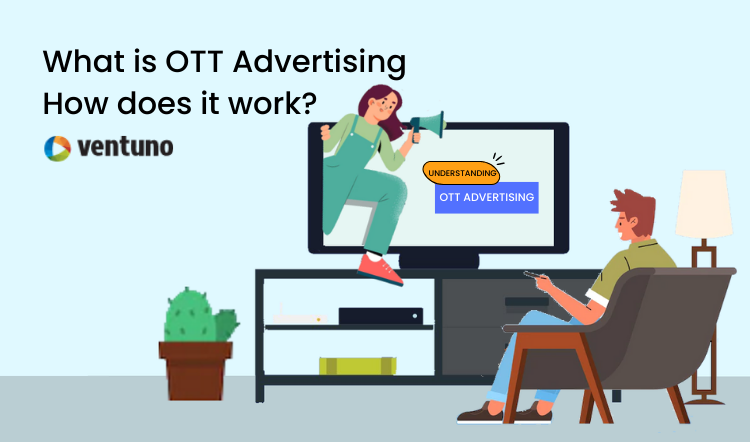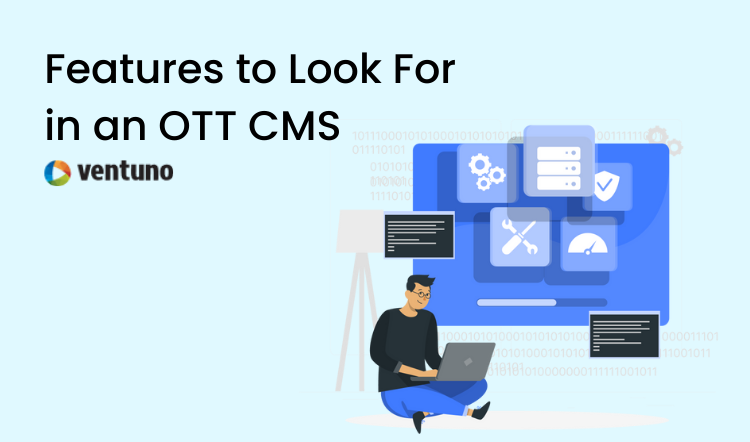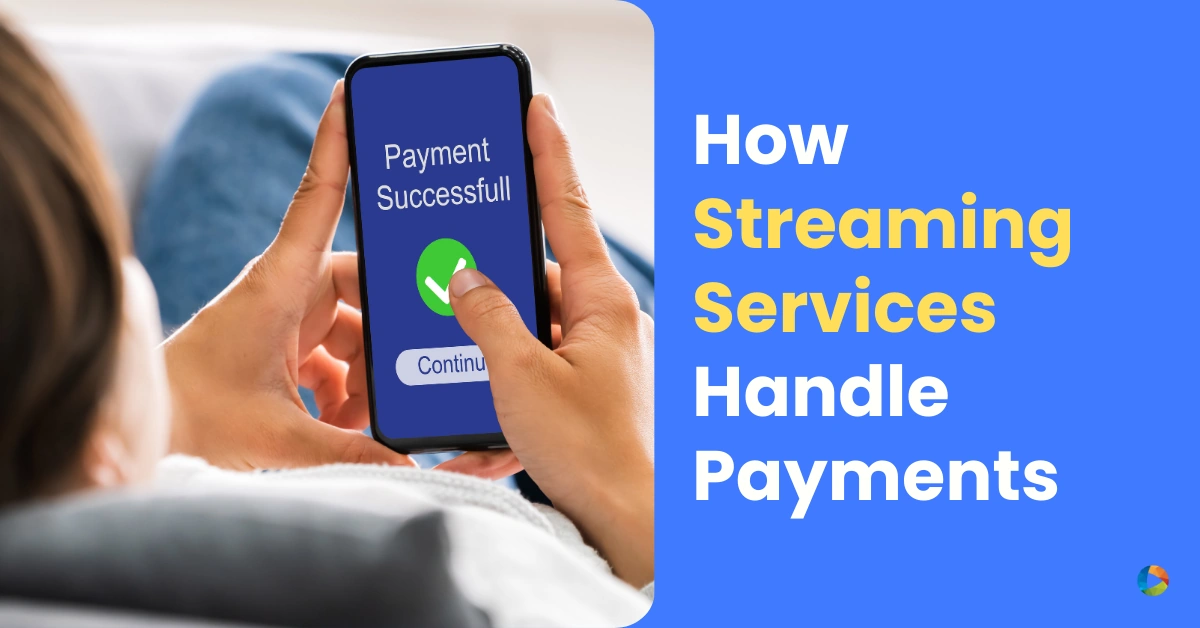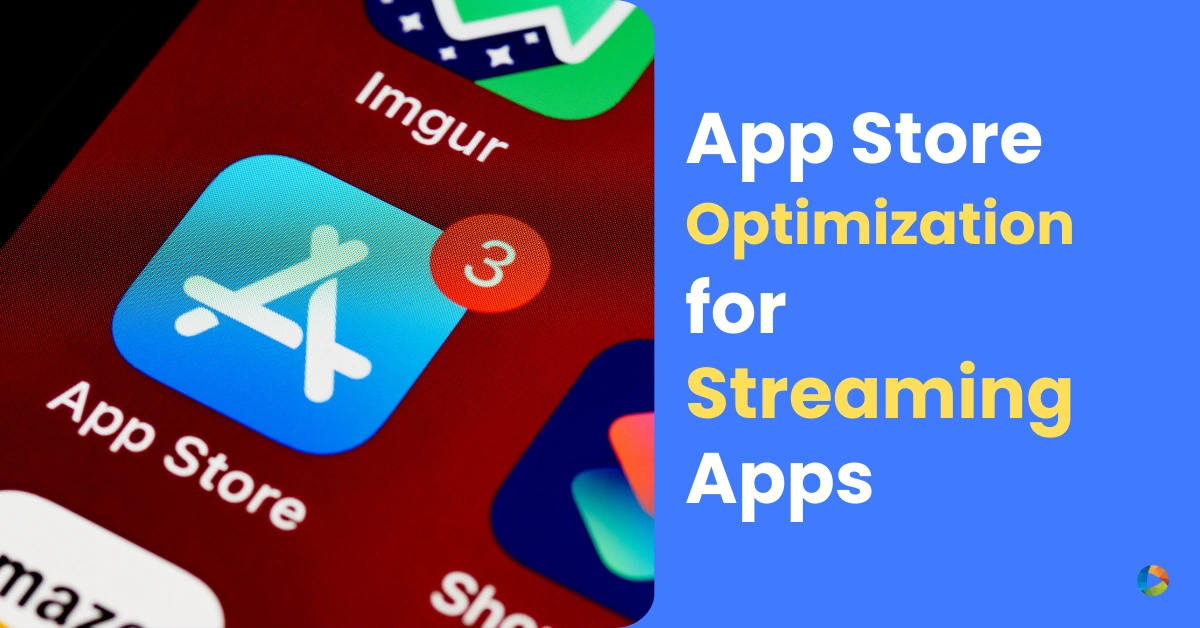What Is OTT Advertising and How Does it Work?
Last Updated on December 30, 2022 by Anjana Devi
If you’ve ever binged a show on Freevee or Discovery+ you would have encountered a few ads. Have you ever wondered how those ads were placed in those videos?
Advertising drives a significant portion of online video revenues. In 2021, the United States alone made $12.9 billion from video ads and is forecasted to make 31.9 billion by 2027.
At the same time, ad-blockers cause significant revenue loss to video content owners. How video ads are delivered or blocked — is something every advertiser and publisher should know.
Ads can be inserted at the beginning, during, or after (pre-roll,mid-roll, post-roll) a video content plays. They are inserted in these slots either from an external client’s server (CSAI – Client Side Ad Integration) or can be hosted in the internal server (SSAI – Server Side Ad Integration )
It is not surprising that the video-based ad monetization landscape has shifted towards SSAI because CSAI faces challenges that SSAI can address. However, CSAI still remains a commonly used ad-delivery method.
Video content publishers were surveyed about how they deliver advertisements to users. The most popular approach was server-side ad insertion (SSAI) at 45%, followed by interstitials (31%) and client-side ad insertion (CSAI) at 24%.

Before knowing the differences between these ad insert models let us understand the basics of OTT advertising
What Is OTT Advertising?
OTT (over-the-top) advertising is advertising delivered directly to viewers over the internet through streaming video devices, such as smart or connected TVs (CTV), mobile phones, laptops, and computers.
We often think of the big names like Roku, Tivo, and FuboTV, but there are plenty of smaller, niche OTT services as well. The ease of creating a video streaming app has made many content creators enter the streaming space. This has given marketers virtually limitless opportunities to advertise on platforms that reach their targeted audience.
Now, let’s analyze why advertisers and marketers prefer OTT advertising.

Learn How to build a successful AVOD streaming service?
Why OTT Advertising Is Growing?
While streaming services are replacing traditional TV, OTT advertising is also transforming traditional advertising. Marketers prefer OTT advertising because,
1. OTT advertising is targeted and measurable
2. Precise targeting eliminates waste
3. Enhanced ad relevance leads to higher engagement
4. Advertisers can manage frequency, and focus on lost customers
5. Advertisers can quantify their reach with accurate tracking
Targetting
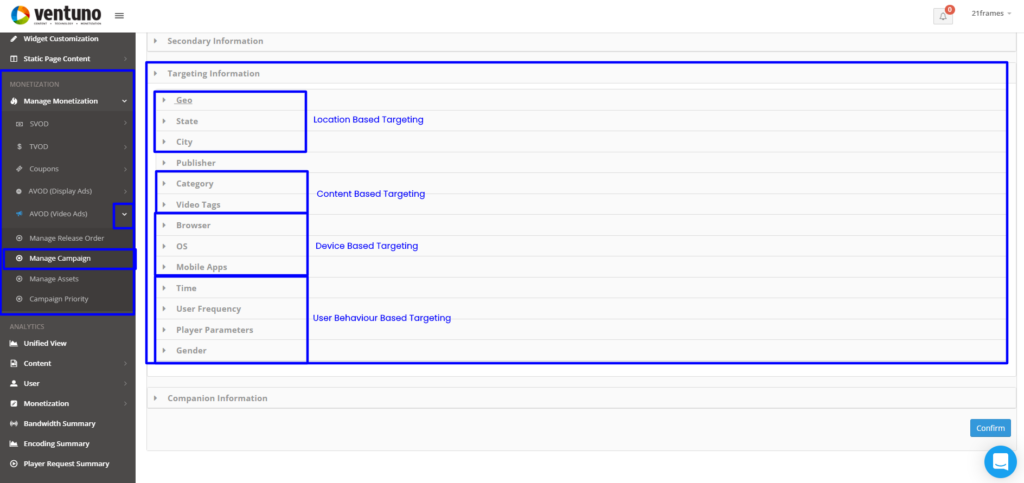
Ventuno - ad targeting optionsAudience insights are essential to running an advertising campaign successfully. Advertisers no longer want their ads to be randomly displayed on any user’s screen. They only want people who are likely to purchase from them to watch their ads. This helps them reduce spend waste.
A fitness equipment brand, for instance, would like to advertise on fitness videos rather than funny cat videos.
Placing ads on relevant content makes the advertiser stay true to their brand voice and message.
Additionally, the right ads can create a personalized experience that builds trust with your audience.
As a publisher, having targeting capabilities gives you an upper hand over your competitors. But you need to get the consent of your audience before placing targeted ads on their screens. A consent management platform would ensure that your streaming service is GDPR and CCPA compliant.
Frequency

Ventuno Ad Frequency CappingBy using data-driven advertising, advertisers can reach audiences with precision and personalize their marketing efforts.
After reaching the target audience, an advertiser’s next concern is about making an impact.
The ad must be seen often enough to be effective at the same time over-exposure to the same ads can cause fatigue in the audience. The right balance is crucial to making an ad campaign successful.
As an OTT platform, you must have the capabilities to cap ad frequency and prioritize campaigns to satisfy the needs of modern marketers and give your audience a non-spammy ad experience.
Measuring
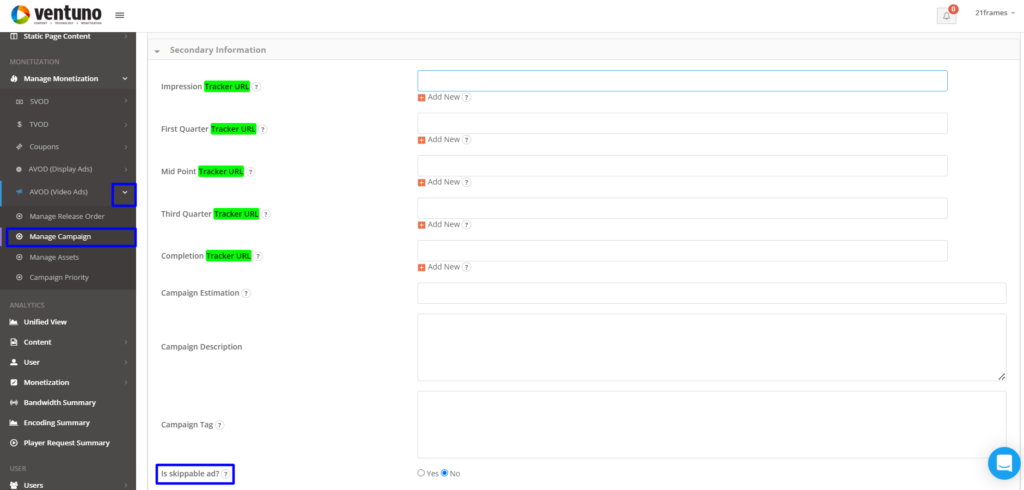
Ventuno Ad campaign TrackingAny digital ad campaign must be measured, and OTT advertising is no different.
For advertisers, it’s important to understand what audiences they are targeting and how their different ads are performing so they know whether their marketing investments are worthwhile.
Unlike traditional TV ads, advertisers can measure the reach of their campaign more comprehensively and can gain audience insights – such as ad skips, ad completion, and click-throughs.
Some useful metrics to measure campaigns are:
1. How many people viewed an advertisement?
2. How many viewers watched the entire ad?
3. At which point of the ad are the viewers skipping it?
4. How many viewers visited the advertiser’s website after viewing the ad?
5. Which OTT device (mobile, TV, laptops) is driving more views and conversions?
For instance, if an advertiser notices that a particular ad is watched through in mobiles and tabs
but is skipped the moment the skip button appears on larger screens like TV and laptops it could be something to do with the resolution. Was the ad pictured with a high-resolution camera? Do the edits and graphics look good on a large screen?
In such cases, the advertiser may want to target different ads for different devices. This granular level of measurement makes OTT ads appealing to advertisers.
Ad Insertion Methods
Now that you have a solid understanding of OTT advertising, let’s look at how ads are inserted
The two most common methods of video-ad insertion are
1. CSAI ( Client Side Ad Insertion)
2. SSAI (Server Side Ad Insertion)
CSAI
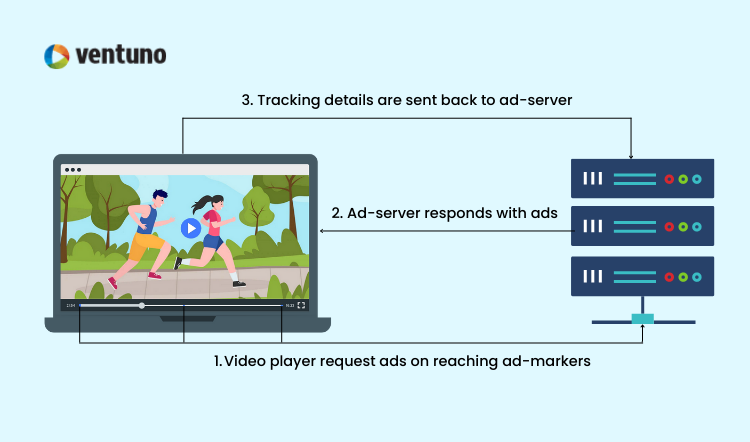
CSAI - how it worksCSAI works by making calls from the video player to an ad server that responds with the ad.
To make it more clear, when viewers watch your videos, the video player(client) requests the ad-server for an ad when it reaches certain parts (ad-markers) of the video. The ad-server responds to this call with an ad.
So..what are ad markers? Have you noticed the yellow markers for ads along the play-line while watching videos on YouTube? These markers denote that ads will be played when the video reaches those points. Those yellow bands are the typical example of ad markers.
SSAI
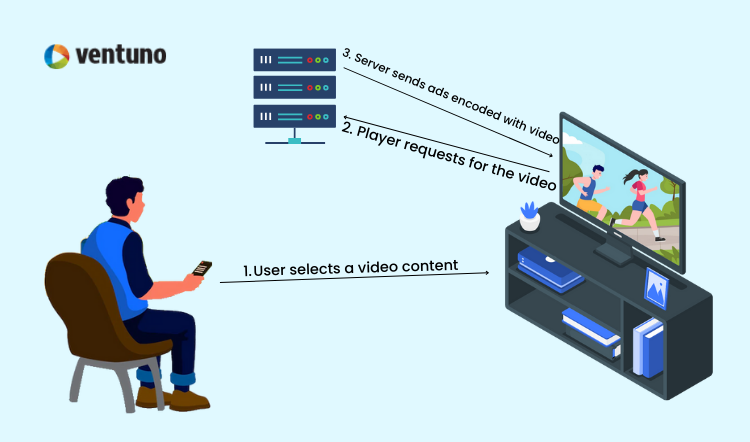
SSAI- how it worksNow let’s understand how SSAI works. In SSAI ads are stitched into the video stream requested by the user at the server and the video player (client) simply plays the ads along with the video without any difference between them.
Now, since the ads are encoded along with the video, the player avoids unnecessary loads at the time of ad playing thus reducing the friction for users.
CSAI vs SSAI
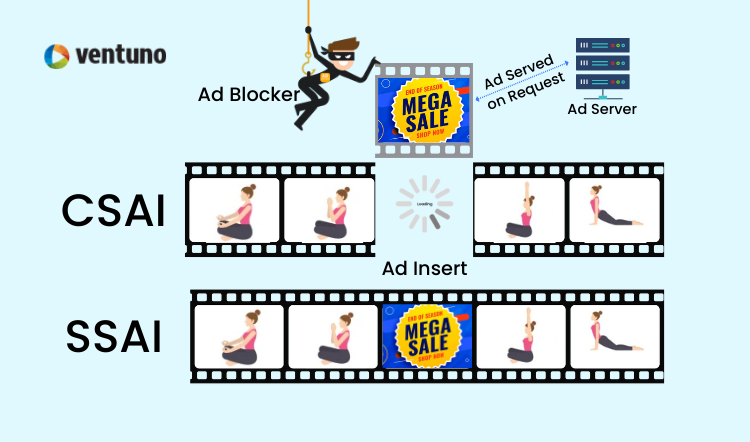
Having learned how CSAI and SSAI work, let’s break down the differences between them
1. Ad-blocker
Ad-blockers are software that filters ads automatically even before they are played.
In CSAI, the player has to explicitly call the ad servers, pause content playback, and start ad playback. Ad blockers can easily detect these calls and block ad playback effectively.
On the other hand, in SSAI, ads are inserted at the server side along with the actual video content. This makes it difficult for ad-blockers to detect and interfere with the ad-plays
2. Loading spinners and buffering:
Ad serving in CSAI starts with the player making a request to an ad-server for an ad and then waiting for that ad to be delivered. This without doubt induces latency and can frustrate the viewer if they are streaming content with a low-speed internet connection.
Moreover, the ad is served from a different server than the video, so the ad may not be in the same bitstream as the video. If the ad is in a higher bitrate, it will start buffering which will surely frustrate the end-user, on the other hand, if the ad is in a lower bitrate it may appear to be lower in quality (pixelated videos) and reduce the viewing experience.
3. Ad Inventory and Personalization
In CSAI, with a large number of data sources, highly personalized ads can be served. Moreover, the inventory can be virtually infinite due to the number of sources and is best suited when a large audience of diverse interests is your audience.
In SSAI, there can be a limitation in the ad inventory, thus complete personalization and maximizing fillrates are not easy.
Wrap Up
Ad-monetization is gaining traction in recent years due to its targeting and analytics capabilities.
In terms of OTT ad-serving technology, both CSAI and SSAI have their advantages and disadvantages. As a publisher, you need to leverage the advantages of both these models by choosing the right platform provider who could support both methods.
To know what works for your platform, track ad performance both based on your video content and from advertisers’ perspectives. This will not only help you maximize your profit but will also give you insights on improving user experience.

Looking to launch your own AVOD streaming service?
